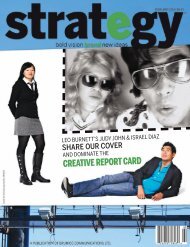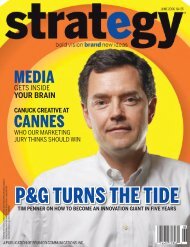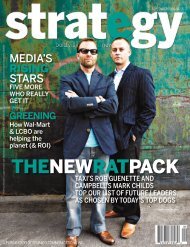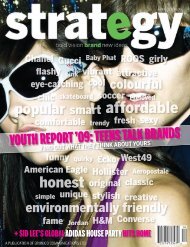Download PDF - Strategy
Download PDF - Strategy
Download PDF - Strategy
Create successful ePaper yourself
Turn your PDF publications into a flip-book with our unique Google optimized e-Paper software.
Tribute. Tide at 60<br />
Tide’s continuing innovation is touted in ads from<br />
1951 (above) and 1963 (right)<br />
tide was the original inspiration for the brand<br />
name. The logo featured concentric orange<br />
and yellow rings representing the suds Tide<br />
created in the wash basin, while the typeface<br />
represented the strength of the product.<br />
P&G cleverly cemented consumer loyalty<br />
by staying true to the original brand over the<br />
years. “The logo hasn’t changed much because<br />
it works,” says Robb Hadley, brand manager for<br />
Tide at Toronto-based P&G Canada. “Today<br />
the logo is an iconic symbol that helps<br />
shop-ability at retail stores that are more<br />
cluttered now than they were 60 years ago.”<br />
P&G was perhaps the original marketing<br />
innovator, introducing product sampling and<br />
promotional premiums and sponsoring daytime<br />
radio serials that became known as “soap<br />
operas,” and was adept at promoting its new<br />
miracle suds. Advertising around the launch of<br />
Tide focused on radio, print, direct mail and<br />
couponing, and included a promotion for two<br />
dozen laundry pins for 25 cents and a proof of<br />
purchase. Newspaper advertising (created by<br />
New York agency Benton & Bowles) was an<br />
important medium for spreading the word, and<br />
headlines such as “amazing new discovery” and<br />
“new freedom” targeted weary housewives. Ads<br />
in magazines like Good Housekeeping were<br />
also a key infl uencer during the ’50s.<br />
The ’50s’ focus on cleanliness and good<br />
housekeeping was also rampant in the<br />
advertising creative of this era. Print ads<br />
depicted alarmingly gleeful housewives<br />
holding a box of Tide aloft as if about to<br />
conquer the world. The message pushed the<br />
point that the product worked even in hard<br />
48 STRATEGY October 2008<br />
water, without the need for water softeners.<br />
“Oceans of suds” was another phrase used<br />
in Tide’s advertising as housewives equated<br />
volumes of suds with cleaning power. In<br />
1949, “Tide’s in, dirt’s out” became a tagline.<br />
By the early ’50s Tide had captured more<br />
than 30% of the laundry market. Advertising<br />
echoed some of the feedback that P&G<br />
received from its consumers, with comments<br />
such as “I’m just crazy about Tide.”<br />
In 1952 Tide was advertised on TV for the<br />
fi rst time, allowing its marketers to visually<br />
demonstrate the power of the product, and<br />
it was actually the fi rst detergent to do a<br />
commercial. One spot depicts a euphoric<br />
woman hanging clothes to dry on a beach, and<br />
subsequently wrapping her tot in a sparkling<br />
clean Tide-washed towel. The tagline: “The<br />
cleanest clean under the sun.”<br />
The science behind Tide began a revolution<br />
in cleaning technology. It was a catalyst for<br />
many other P&G products, including Cheer<br />
detergent in 1952, a highly successful<br />
follow-up to Tide. Mr Clean, which launched<br />
in 1958, was one of many products to make<br />
use of Tide’s surfactant technology.<br />
1958 TO 1968:<br />
NEW AND<br />
IMPROVED AND<br />
INTENSIFIED<br />
During the post-war<br />
economic boom, wringer<br />
washers were joyfully<br />
ditched for new-fangled<br />
automatic washing machines. P&G capitalized<br />
on this major shift by advertising Tide in<br />
conjunction with washer manufacturers.<br />
Boxes of Tide were placed inside new<br />
machines to convince consumers to try the<br />
product. Print ads displayed the detergent and<br />
the washer, with the tagline “The makers of 25<br />
automatics recommend Tide.” One from 1965<br />
pictures a housewife pulling a box of Tide out of<br />
her new washer. The headline reads: “The best<br />
recommendation for Tide comes inside every<br />
new Westinghouse Heavy Duty Washer.” The<br />
subsequent tagline: “Waltz through washday<br />
with a new Westinghouse and Tide.”<br />
As rival brands reached the market, Tide’s<br />
scientists made subtle changes to its formula,<br />
subsequently touting “Improved Tide” and<br />
“New Intensifi ed Tide.” The packaging and the<br />
“washday miracle” message remained unchanged.<br />
P&G strove to meet consumer needs by<br />
making use of its market research department,<br />
created in 1924, to study buying habits.<br />
During the ’50s researchers at P&G Canada<br />
found that since the levels of water hardness<br />
varied from province to province, there was a<br />
demand for geographically localized products.<br />
www.strategymag.com<br />
They therefore created three different Tide<br />
formulas for distribution in different regions.<br />
On the ad front, in the early ’60s Benton<br />
& Bowles handed the reins to N.Y.C.-based<br />
Saatchi & Saatchi Advertising Worldwide,<br />
which still holds the Tide account.<br />
Print ads from this period started to feature<br />
the objective of the detergent, as opposed to the<br />
squeaky clean housewives. One ad from 1959<br />
shows a small boy playing in a muddy puddle<br />
while another features a dog lying on a bed with<br />
muddy paw-prints on the blanket. The message<br />
on both: “It’s a good thing that Tide keeps on<br />
working after other suds have quit.”<br />
TV spots began to demonstrate Tide’s<br />
cleaning ability, and compare it to other<br />
brands. A “hidden T-shirt test” was a staple of<br />
the late ’60s, in which a dirty T-shirt comes<br />
out looking like new, even when hidden inside<br />
other dirty clothes in the washer. “Dirt can’t<br />
hide from intensifi ed Tide” was the tagline.<br />
1968-1978: CUE<br />
THE REAL WOMEN<br />
Celebrity endorsement<br />
was used during this<br />
decade, with stars<br />
such as actress Jane<br />
Wyatt appearing in ads<br />
of the late ’60s. But<br />
as this was a time of<br />
empowered, savvy women, P&G also turned to<br />
real consumers to do the convincing. In 1970<br />
Tide was actually the fi rst detergent to go this<br />
route, with TV spots featuring real women<br />
refusing to swap their box of Tide for twice as














